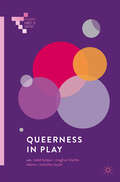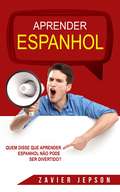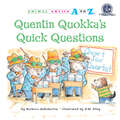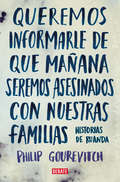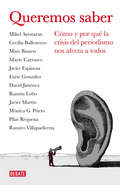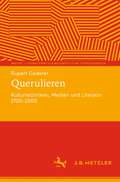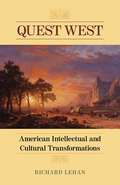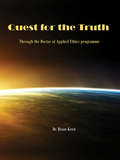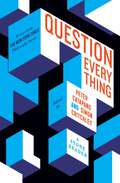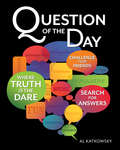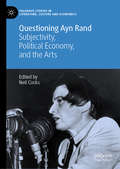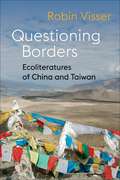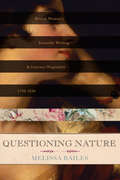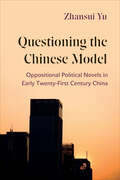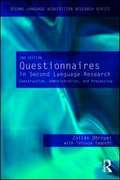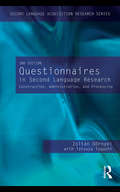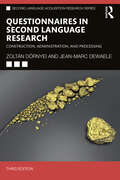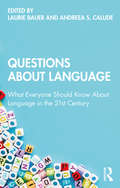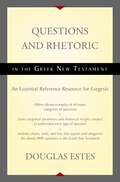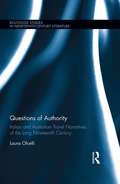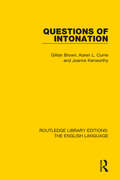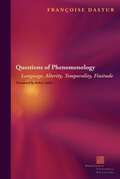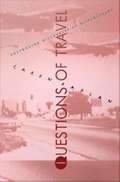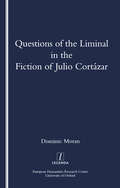- Table View
- List View
Queerness in Play (Palgrave Games in Context)
by Nicholas Taylor Todd Harper Meghan Blythe AdamsQueerness in Play examines the many ways queerness of all kinds—from queer as ‘LGBT’ to other, less well-covered aspects of the queer spectrum—intersects with games and the social contexts of play. The current unprecedented visibility of queer creators and content comes at a high tide of resistance to the inclusion of those outside a long-imagined cisgender, heterosexual, white male norm. By critically engaging the ways games—as a culture, an industry, and a medium—help reproduce limiting binary formations of gender and sexuality, Queerness in Play contributes to the growing body of scholarship promoting more inclusive understandings of identity, sexuality, and games.
Quem Disse Que Aprender Espanhol Não Pode Ser Divertido?
by Zavier Jepson Miguel Matos>> Compre a Edição em Papel Deste Livro e Ganhe a Versão Kindle de GRAÇA Você está procurando dar uma melhorada no seu espanhol? Quer aprender o idioma o mais rápido possível para o próximo feriado ou reunião familiar? Então você veio ao lugar certo! Quem Disse Que Aprender Espanhol Não Pode Ser Divertido? te tornará fluente rapidinho, com um método de aprendizado mais rápido que te fará dominar o espanhol em apenas 3 dias! Neste livro você aprenderá: • Técnicas Para o Aprendizado de Idiomas • Pronúncias Corretas, Verbos e Frases Básicas Para Conversas do Dia a Dia em Espanhol • Construção de Uma Rotina de Aprendizado em Espanhol • Super Aula de 3 Dias!!! • Guia Estendido de 30 Dias Para Falar Espanhol • ... E muito, muito mais! Não espere mais! Desça a Página e Clique Em Comprar Para Adquirir Este Livro HOJE. Comece a Melhorar Seu Espanhol Agora!
Quentin Quokka's Quick Questions (Animal Antics A to Z)
by Barbara deRubertisQuentin Quokka has lots of questions! Quick questions, quiet questions—always more questions! On a string of field trips, Quentin discovers that sometimes it’s good to be quiet . . . and sometimes it’s good to ask questions!
Queremos informarle de que mañana seremos asesinados con nuestras familias: Historias de Ruanda
by Philip GourevitchUn extraordinario reportaje, ganador de numerosos premios internacionales, sobre el genocidio ruandés. El 6 de abril de 1994, el avión del presidente de Ruanda fue abatido por un misil. Al día siguiente el gobierno animaba a la mayoría hutu a asesinar a sus vecinos tutsis junto con aquellos hutus que intentasen protegerlos. De este modo daba comienzo el mayor genocidio de las últimas décadas. En los cien días que transcurrieron hasta que el Frente Patriótico Ruandés, la guerrilla tutsi, puso fin a la masacre haciéndose con el control del país, murieron 800.000 personas según los cálculos más conservadores, casi 10.000 al día, 400 a la hora, 7 por minuto; la mayoría de ellas a machetazos, el arma preferida. En este extraordinario reportaje -un clásico del periodismo contemporáneo- Philip Gourevitch emprende un viaje al corazón de las tinieblas para indagar en los motivos de tan atroz baño de sangre. Su prosa lúcida e inteligente desenmascara la pasividad de la comunidad internacional, que asistió paralizada a semejante carnicería, prefiriendo no asumir riesgos frente a un país que hasta el momento había sido modélico y que no tenía petróleo ni riquezas que ofrecer. El resultado, tras varios viajes por Ruanda y centenares de entrevistas y conversaciones con víctimas y verdugos, es esta sobrecogedora narración -ganadora de numerosos premios internacionales como el Guardian First Book Award, el National Book Critics Circle Award, el George Polk Book Award y el Los Angeles Times Book Prize-, que no dejará indiferente a ningún lector. Reseñas:«Inquietantemente bello y brillante, este es un libro asombrosamente bueno. Debería estar en las estanterías para siempre.»Tom Engelhardt, The Philadelphia Inquirer «El libro más importante que he leído en muchos años [...] Gourevitch examina el genocidio en Ruanda con humildad, ira, dolor y un nivel extraordinario de inteligencia política y moral.»Susie Linfield, Los Angeles Times «Gourevitch tiene la mente de un investigador combinada con la capacidad de observación de un buen novelista, y escribe como los ángeles. Este libro lo convierte en un igual de Michael Herr, Ryszard Kapuscinski y Tobias Wolff. Creo que no existe límite sobre lo que debemos esperar de él.»Robert Stone «Una crónica aleccionadora, reveladora y profundamente reflexiva.»The Boston Globe «Este absorbente relato debería ser de lectura obligada para aquellos investigadores del funcionamiento interno de los estados modernos.»The Washington Post
Queremos saber: Cómo y por qué la crisis del periodismo nos afecta a todos (Libros para entender la crisis #Volumen)
by Varios AutoresEn Queremos saber, doce periodistas de una amplia trayectoria internacional reflexionan sobre la crisis que está atravesando el periodismo y explican las nefastas consecuencias que eso tiene para el correcto funcionamiento de una democracia. La crisis económica general ha coincidido en el tiempo con una crisis propia de los medios de comunicación y por tanto del periodismo, obligado a adaptarse a la nueva realidad digital. Como en toda crisis, se corre el riesgo de recortar cosas fundamentales, y conservar otras accesorias: suprimir lo más caro, no lo menos necesario. En un medio lo más caro es la información internacional propia de calidad, por eso en esa sección se pueden ver aumentados los problemas y los desafíos del periodismo. Reseñas:«No recuerdo cuándo, exactamente, explicar en la redacción la importancia de la historia vivida, relatada en forma de reportaje, se convirtió en una tarea más ardua que atravesar fronteras, esquivar ataques, granjearse la confianza de combatientes y civiles, y superar el miedo para convertirse así en testigo directo de los hechos. En mi opinión, eso marca el momento de la crisis existencial del periodismo.»Mónica G. Prieto «Hoy más que nunca los periódicos deberían apostar por las historias propias, los reportajes, y olvidarse de un concepto que sí que se ha quedado anticuado debido a internet, la noticia de ayer.»Javier Espinosa «El corresponsal ha dejado de tener sentido si no es para ofrecer profundidad frente a la inmediatez, precisión frente a la falta de rigor, reporterismo literario frente a la escritura urgente y originalidad frente al rebaño que hemos formado los medios de comunicación.»David Jiménez «El buen periodismo seguirá siendo propiedad de los buenos periodistas, de aquellos que prefieran formular preguntas incómodas a escribir al dictado, que indaguen en el origen, buceen en las causas y sepanleer entre líneas, sin importar el tipo de plataforma que se utilice.»Javier Martín «Si renunciamos a enviar periodistas a los sitios, no ya a Afganistán, sino a la calle de enfrente; si creemos que una pantalla de ordenador o de una tableta, por muy HD y táctil que sea, puede reemplazar el olor, el color, el miedo, la soledad, las voces y sus silencios, habremos matado el reportaje y el periodismo. Seremos innecesarios, sólo puro entretenimiento.»Ramón Lobo «Pese a la efervescencia de internet, son los medios poderosos los que deciden de qué se habla y de qué no. [...] Cualquier guerra, cualquier genocidio, es peor cuando falta información.»Enric González
Querulieren: Kulturtechniken, Medien und Literatur 1700-2000 (Media. Literaturwissenschaftliche Forschungen)
by Rupert GadererEnde des 18. Jahrhunderts wird zum ersten Mal der Typus des „Querulanten“ beschrieben. Es handelt sich um einen devianten Kläger, der mit unzähligen Schreiben die bürokratische Kommunikation stört, die Arbeitskapazität der Gerichte erschöpft und nötigenfalls mit Waffengewalt um sein Recht kämpft. In dieser Zeit wird das Querulantentum in unterschiedlichen Wissensfeldern virulent. Ausgehend von institutionellen Verordnungen, juristischen Diskussionen und psychiatrischen Falldarstellungen rekonstruiert die Studie erstmals eine systematische Medien- und Literaturgeschichte des Querulierens von der Aufklärung bis in die Gegenwart.
Quest West: American Intellectual and Cultural Transformations
by Richard LehanFew spaces remain as central to American consciousness as the western frontier. The vast territory, which for generations fueled the desires and conquests of artists, philosophers, and politicians alike, now offers new discoveries in Richard Lehan's Quest West. Through an intellectual and cultural history of the frontier experience, Lehan details the transformations of ideas and literary forms that occurred as the country expanded to the west and demonstrates how the wilderness, and then by turn the urban frontier, represent an ideological summary of the nation itself. His study involves the foundations of belief and the realms of evolving interpretations, from mythic destiny to the more regional address of historicism. In both instances, the desire is to find meaning in the lost past.By tracing the evolution of Frederick Jackson Turner's famous thesis -- that the unchartered frontier ended in 1890 and was replaced with an equally precarious urban landscape -- Lehan argues that the two spaces became the basis for a division still evident in America today. Historically, the wilderness accommodated conservative thinking, while urban environments proved more conducive to liberal values. Ideologies stemming from the two regions, as Lehan shows, found literary equivalents in fictional narratives ranging from subgenres like the Western and naturalism to modern forms like neorealism and noir, extending even into the postmodern. Lehan offers a view of the West as a cultural phenomenon borne of ideological changes, encompassing historical and literary movements -- from Puritan perspectives to the revisionist claims of Mark Twain and Walt Whitman, from homesteading to imperial ambition. Quest West traces these competing ideas as they appear in the works of major American writers such as James Fenimore Cooper, Walt Whitman, Willa Cather, William Faulkner, F. Scott Fitzgerald, John Dos Passos, Nathanael West, and John Steinbeck. An important work of literary and historical scholarship, Quest West presents compelling evidence that the meaning of America remains inseparable from the march of seminal ideas westward.
Quest for the Truth Through the Doctor of Applied Ethics programme
by Dr Brian KeenThis is your invitation to participate in the Quest for the Truth. This is one of the greatest quests in the world since the Truth is an absolute necessity. This is one of the greatest challenges for you today. As the author, I'm inviting you to join me in this Quest. The Truth isn't a concept. The Truth is a real goal for the benefit of all mankind. The Truth teaches us and challenges us. We learn to love through the Truth. You will learn the Truth utilizing the same methodologies as all scientists. Aside from the Doctor of Applied Ethics (DAE) degree programme there is no doctorate degree that allows the student to acquire the tools to diagnose the problems relating to an enterprise that uses scientifically-verifiable objective standards. The term enterprise represents any type of business or organization, including charitable ones or associations. The key is to live for the Truth. When you live for the Truth you will find this doctorate programme appropriate. Ethicists seek the Truth through Illumination in order to become a doctor who can diagnose and offer therapy to those who are hurting.
Question Everything: A Stone Reader
by Peter Catapano and Simon CritchleyAn essential addition to the Stone Reader series, Question Everything is a groundbreaking collection of philosophical essays from some of our foremost thinkers and storytellers. When The Stone Reader—a landmark collection of 133 essays from the New York Times’ award-winning philosophy column—first published, in 2015, the world urgently needed insight and wisdom, and for many, the book served as a bulwark of reason against the rising tide of post-fact rhetoric. Now, as disinformation continues to run rampant and our rights are increasingly called into question, editors Peter Catapano and Simon Critchley contend that philosophy in the public sphere is more crucial than ever. Like The Stone Reader and its sequel, Modern Ethics in 77 Arguments, Question Everything delivers the contrarian views, sound arguments, and creative approaches to traditional opinion-writing that loyal readers of the series have come to expect. Its essays, however, are not organized by traditional categories like ethics or epistemology, but thematically by question, thirteen of them in all—the first twelve like the hours of a clock, ticking us through the tumultuous time in which these pieces were written, from late 2015 to 2021, with the last speculating into an uncertain future. The volume begins with the most fundamental of questions: What does it mean to be human? There, contemporary thinkers from Martha Nussbaum to Bernard-Henri Lévy explore the essence of who we are as a species. The next question—Is democracy possible?—interrogates our social and political ideals. While Malka Older calls into question the viability of our institutions, philosophers Gary Gutting and Alex Rosenberg reassess the meaning of patriotism. And onward, with more timeless struggles: What is happiness? Does life have meaning? Finally, it asks, Is this the end of the world as we know it? Now what? While its foundation and core consists of the work of professional scholars and philosophers, Question Everything also features a number of prominent artists and thinkers who may never appear on a philosophy syllabus, including, among others, novelist Elena Ferrante, actor Cate Blanchett, filmmaker Errol Morris, musician Sonny Rollins, and artist Ai Weiwei, all of whom offer insights shaped by decades of devotion to and practice of their crafts. Designed both for immediate gratification and long-term use, Question Everything, with an introduction by Catapano, is not only an essential addition to a much-loved series, but an act of resistance, “a product,” as Catapano writes, “of the spirit of agitation and inquiry that has been integral to the human enterprise from the beginning of recorded history.”
Question of the Day: Where Truth is the Dare
by Al KatkowskyPerfect for spending time with friends, family or even co-workers, Question of the Day is designed to help people explore a variety of topics that challenge them to think, be brutally honest, and form perhaps previously unstated opinions. Using these questions is fun, enlightening, surprising and revealing'ideal as an ice breaker among willing acquaintances or as a source of deeper conversation among old friends. It's fun, but also challenging and the subtitle is meant to reflect that. Questions are ranked on a scale from 'light' to 'heavy' indicating the introspection, honesty, and even deep thinking required by the individuals the question is posed to. The questions can incite funny answers, embarrassment'even an unwillingness to answer. But every reaction to a question reveals to the group insights into the beliefs of the people answering. "Question of the Dayreads and plays like a game. The result is a much more stimulating version of The Book of Questions. ' -- Glenn Taverna, general manager, Border Books and Music Westbury, NY
Questioning Ayn Rand: Subjectivity, Political Economy, and the Arts (Palgrave Studies in Literature, Culture and Economics)
by Neil CocksQuestioning Ayn Rand: Subjectivity, Political Economy, and the Arts offers a sustained academic critique of Ayn Rand’s works and her wider Objectivist philosophy. While Rand’s texts are often dismissed out of hand by those hostile to the ideology promoted within them, these essays argue instead that they need to be taken seriously and analysed in detail. Rand’s influential worldview does not tolerate uncertainty, relying as it does upon a notion of truth untroubled by doubt. In contrast, the contributors to this volume argue that any progressive response to Rand should resist the dubious comforts of a position of ethical or aesthetic purity, even as they challenge the reductive individualistic ideology promoted within her writing. Drawing on a range of sources and approaches from Psychoanalysis to The Gold Standard and from Hannah Arendt to Spiderman, these essays consider Rand’s works in the context of wider political, economic, and philosophical debates.
Questioning Borders: Ecoliteratures of China and Taiwan (Global Chinese Culture)
by Robin VisserIndigenous knowledge of local ecosystems often challenges settler-colonial cosmologies that naturalize resource extraction and the relocation of nomadic, hunting, foraging, or fishing peoples. Questioning Borders explores recent ecoliterature by Han and non-Han Indigenous writers of China and Taiwan, analyzing relations among humans, animals, ecosystems, and the cosmos in search of alternative possibilities for creativity and consciousness.Informed by extensive field research, Robin Visser compares literary works by Bai, Bunun, Kazakh, Mongol, Tao, Tibetan, Uyghur, Wa, Yi, and Han Chinese writers set in Xinjiang, Tibet, Inner Mongolia, Southwest China, and Taiwan, sites of extensive development, migration, and climate change impacts. Visser contrasts the dominant Han Chinese cosmology of center and periphery that informs what she calls “Beijing Westerns” with Indigenous and hybridized ways of relating to the world that challenge borders, binaries, and hierarchies.By centering Indigenous cosmologies, this book aims to decolonize approaches to ecocriticism, comparative literature, and Chinese and Sinophone studies as well as to inspire new modes of sustainable flourishing in the Anthropocene.
Questioning Nature: British Women's Scientific Writing and Literary Originality, 1750-1830
by Melissa BailesIn the mid-eighteenth century, many British authors and literary critics anxiously claimed that poetry was in crisis. These writers complained that modern poets plagiarized classical authors as well as one another, asserted that no new subjects for verse remained, and feared poetry's complete exhaustion. Questioning Nature explores how major women writers of the era—including Mary Shelley, Anna Barbauld, and Charlotte Smith—turned in response to developing disciplines of natural history such as botany, zoology, and geology. Recognizing the sociological implications of inquiries in the natural sciences, these authors renovated notions of originality through natural history while engaging with questions of the day. Classifications, hierarchies, and definitions inherent in natural history were appropriated into discussions of gender, race, and nation. Further, their concerns with authorship, authority, and novelty led them to experiment with textual hybridities and collaborative modes of originality that competed with conventional ideas of solitary genius.Exploring these authors and their work, Questioning Nature explains how these women writers' imaginative scientific writing unveiled a new genealogy for Romantic originality, both shaping the literary canon and ultimately leading to their exclusion from it.
Questioning the Chinese Model: Oppositional Political Novels in Early Twenty-First Century China
by Zhansui YuIn the early twenty-first century, the Chinese literary world saw an emergence of fictional works – dubbed as "oppositional political novels" – that took political articulation as their major purpose and questioned the fundamental principles and intrinsic logic of the Chinese model. Based on close readings of five representative oppositional Chinese political novels, Questioning the Chinese Model examines the sociopolitical connotations and epistemological values of these novels in the broad context of modern Chinese intellectual history and contemporary Chinese politics and society. Zhansui Yu provides a sketch of the social, political, and intellectual landscape of present-day China. He investigates the dialectic relationship between the arts and politics in the Chinese context, the mechanisms and dynamics of censorship in the age of the Internet and commercialization, and the ideological limitations of oppositional Chinese political novels. In the process of textual and social analysis, Yu extensively cites Western political philosophers, such as Hannah Arendt, Antonio Gramsci, Michel Foucault, and references well-regarded studies on Chinese literature, politics, society, and the Chinese intelligentsia. Examining oppositional Chinese political novels from multiple perspectives, Questioning the Chinese Model applies a broad range of knowledge beyond merely the literary field.
Questionnaires in Second Language Research: Construction, Administration, and Processing
by Zoltan Dornyei Tatsuya TaguchiQuestionnaires in Second Language Research: Construction, Administration, and Processing is the first guide in the second language field devoted to the question of how to produce and use questionnaires as reliable and valid research instruments. It offers a thorough overview of the theory of questionnaire design, administration, and processing, made accessible by concrete, real-life second language research applications. This Second Edition features a new chapter on how an actual scientific instrument was developed using the theoretical guidelines in the book, and new sections on translating questionnaires and collecting survey data on the Internet. Researchers and students in second language studies, applied linguistics, and TESOL programs will find this book invaluable, and it can also be used as a textbook for courses in quantitative research methodology and survey research in linguistics, psychology, and education departments.
Questionnaires in Second Language Research: Construction, Administration, and Processing (2nd Edition)
by Tatsuya Taguchi Zoltán DörnyeiQuestionnaires in Second Language Research: Construction, Administration, and Processing is the first guide in the second language field devoted to the question of how to produce and use questionnaires as reliable and valid research instruments. It offers a thorough overview of the theory of questionnaire design, administration, and processing, made accessible by concrete, real-life second language research applications. This Second Edition features a new chapter on how an actual scientific instrument was developed using the theoretical guidelines in the book, and new sections on translating questionnaires and collecting survey data on the Internet. Researchers and students in second language studies, applied linguistics, and TESOL programs will find this book invaluable, and it can also be used as a textbook for courses in quantitative research methodology and survey research in linguistics, psychology, and education departments.
Questionnaires in Second Language Research: Construction, Administration, and Processing (Second Language Acquisition Research Series)
by Zoltán Dörnyei Jean-Marc DewaeleQuestionnaires in Second Language Research is the first state-of-the-art methodological guide for producing and using questionnaires as reliable and valid research instruments in second language studies. Zoltán Dörnyei and Jean-Marc Dewaele provide a comprehensive, reader-friendly overview of the theory of questionnaire design, administration, and processing, made accessible with a detailed how-to guide and concrete, real-life applications. This new edition is thoroughly updated to reflect developments in the field and with recent example studies that focus on considerations, challenges, and opportunities raised at all stages of the research process by online questionnaires. There is also expanded, detailed guidance on how to use the IRIS database and how to clean, process, and analyze questionnaire data prior to determining and reporting findings. This is an invaluable resource to students and researchers of SLA, applied linguistics, psychology, and education who are interested in understanding and conducting quantitative L2 research using questionnaires and surveys.
Questions
by Jan P. de RuiterThe view that questions are 'requests for missing information' is too simple when language use is considered. Formally, utterances are questions when they are syntactically marked as such, or by prosodic marking. Functionally, questions request that certain information is made available in the next conversational turn. But functional and formal questionhood are independent: what is formally a question can be functionally something else, for instance, a statement, a complaint or a request. Conversely, what is functionally a question is often expressed as a statement. Also, verbal signals such as eye-gaze, head-nods or even practical actions can serve information-seeking functions that are very similar to the function of linguistic questions. With original cross-cultural and multidisciplinary contributions from linguists, anthropologists, psychologists and conversation analysts, this book asks what questions do and how a question can shape the answer it evokes.
Questions About Language: What Everyone Should Know About Language in the 21st Century
by Laurie Bauer Andreea S. CaludeQuestions About Language sets out to answer, in a readable yet insightful format, a series of vital questions about language, some of which language specialists are regularly asked, and some of which are so surprising that only the specialists think about them. In this handy guide, sixteen language experts answer challenging questions about language, from What makes a language a language? to Do people swear because they don’t know enough words? Illustrating the complexity of human language, and the way in which we use it, the twelve chapters each end with a section on further reading for anyone interested in following up on the topic. Covering core questions about language, this is essential reading for both students new to language and linguistics and the interested general reader.
Questions and Rhetoric in the Greek New Testament: An Essential Reference Resource for Exegesis
by Douglas EstesWhile there are almost 1000 questions in the Greek New Testament, many commentators, pastors, and students skip over the questions for more ‘theological’ verses or worse they convert questions into statements to mine them for what they are saying theologically. However, this is not the way questions in the Greek New Testament work, and it overlooks the rhetorical importance of questions and how they were used in the ancient world. Questions and Rhetoric in the Greek New Testament is a helpful and thorough examination of questions in the Greek New Testament, seen from the standpoint of grammatical, semantic, and linguistic analysis, with special emphasis on their rhetorical effects. It includes charts, tools, and lists that explain and categorize the almost 1000 questions in the Greek New Testament. Thus, the user is able to go to the section in the book dealing with the type of question they are studying and find the exegetical parameters needed to understand that question. Questions and Rhetoric in the Greek New Testament offers vibrant examples of all the major categories of questions to aid the reader in grasping how questions work in the Greek New Testament. Special emphasis is given to the way questions persuade and influence readers of the Greek New Testament.
Questions of Authority: Italian and Australian Travel Narratives of the Long Nineteenth Century (Routledge Studies in Nineteenth Century Literature)
by Laura OlcelliQuestions of Authority investigates Italian–Australian literary travel exchanges throughout the long nineteenth century. The 1800s witnessed major transformations in Australian overseas travel: it gradually evolved from a replica of the Continental Grand Tour of the British, to a more idiosyncratic cosmopolitan experience, either touristic or professional. Moreover, it was during the second half of this century that both Italy and Australia underwent crucial political upheavals; these resulted in shifts from colonial and subjugated status, to self-government and ultimately independence. This volume connects these geographical, political and sociocultural contexts of Italy and Australia by considering their interlaced odeporic library, produced at a significant time in history. Additionally, this book analyses key texts compiled by Italians in Australia, and Australians in Italy: these chiefly consist of voyage accounts, but also include the records of explorers, missionaries, scientists and migrants coming from the Italian peninsula. These primary sources include unpublished travel diaries compiled by the first Victorian women visitors to the Bel Paese, which have been largely neglected by scholarship thus far. This examination pinpoints the enduring significance of Italy in travel-related terms, showing how this destination was adapted from the map of eighteenth-century British Grand Tourists, to that of nineteenth-century Australian holiday makers. Most critically, Questions of Authority argues Italian–Australian peripatetic connections entail issues of authority, that emerge in the ways in which Italian and Australian travel writers displayed their authorship, cultural capital and national identification in relation to the other country. Finally, it demonstrates how these are highly regulated by, and yet simultaneously challenge, British colonial hegemony.
Questions of Intonation (Routledge Library Editions: The English Language #5)
by Gillian Brown Karen L. Currie Joanne KenworthyFirst published in 1980, this book questions many of the assumptions that have accumulated around the subject of intonation as it occurs in spontaneous speech, as well as texts read aloud. The book suggests alternative ways of examining the subject and primarily uses data derived from Edinburgh speech, which is explicitly compared with descriptions of standard southern English. The book critically examines many conventional assumptions made about the formal features of intonation, particularly ‘tonic’ or primary stress’, and about the functions of intonation, specifically rising intonation. A model of intonation is presented which demonstrates that the limited resources of intonation are exploited by several different expressive systems. This approach is justified in detailed analysis of extensive stretches of speech, supported by instrumental analysis as well as by experiments which elicit judgements by both naïve and phonetically trained judges. This book will be of interest to students of linguistics, English Language, speech therapy, and English as a Foreign Language, as well as historians interested in the history of language.
Questions of Phenomenology: Language, Alterity, Temporality, Finitude (Perspectives in Continental Philosophy)
by Françoise DasturFrançoise Dastur is well respected in France and Europe for her mastery of phenomenology as a movement and her clear and cogent explications of phenomenology in movement. These qualities are on display in this remarkable volume. Dastur guides the reader through a series of phenomenological questions—language and logic, self and other, temporality and history, finitude and mortality—that also call phenomenology itself into question, testing its limits and pushing it in new directions. Like Merleau-Ponty, Dastur sees phenomenology not as a doctrine, a catalogue of concepts and catchphrases authored by a single thinker, but as a movement in which several thinkers participate, each inflecting the movement in unique ways. In this regard, Dastur is both one of the clearest guides to phenomenology and one of its ablest practitioners.
Questions of Travel: Postmodern Discourses of Displacement
by Caren KaplanContemporary theory is replete with metaphors of travel--displacement, diaspora, borders, exile, migration, nomadism, homelessness, and tourism to name a few. In Questions of Travel, Caren Kaplan explores the various metaphoric uses of travel and displacement in literary and feminist theory, traces the political implications of this "traveling theory," and shows how various discourses of displacement link, rather than separate, modernism and postmodernism. Addressing a wide range of writers, including Paul Fussell, Edward Said, James Clifford, Gilles Deleuze, Jean Baudrillard, Gayatri Spivak, Edward Soja, Doreen Massey, Chandra Mohanty, and Adrienne Rich, Kaplan demonstrates that symbols and metaphors of travel are used in ways that obscure key differences of power between nationalities, classes, races, and genders. Neither rejecting nor dismissing the powerful testimony of individual experiences of modern exile or displacement, Kaplan asks how mystified metaphors of travel might be avoided. With a focus on theory's colonial discourses, she reveals how these metaphors continue to operate in the seemingly liberatory critical zones of poststructuralism and feminist theory. The book concludes with a critique of the politics of location as a form of essentialist identity politics and calls for new feminist geographies of place and displacement. An important and timely intervention into contemporary theoretical debates, Questions of Travel will be of interest to scholars in a wide variety of disciplines, including literary criticism, cultural studies, feminist theory, colonial and postcolonial studies, geography, anthropology, and sociology.
Questions of the Liminal in the Fiction of Julio Cortazar
by Domenic Moran"The great Argentinian writer Julio Cortazar (1914-84) was immersed in one of the most vibrant and revolutionary intellectual scenes of the last century, the Paris of the 1950s and 60s. Yet his often highly cerebral work has never received the close philosophical attention it deserves. Moran's book fills this critical lacuna. Rather than indiscriminately applying 'theory' to Cortazar, it aims to show that his work both engages with and often foreshadows many of the problems which were to become central to so-called poststructuralist philosophy and poetics. This study demonstrates that Cortazar remains enduringly, problematically modern."
